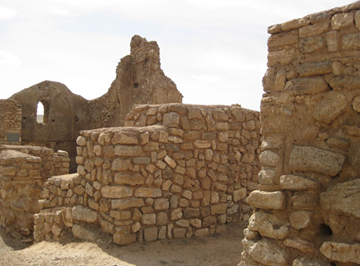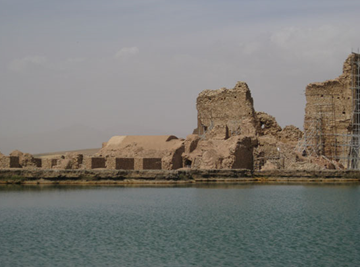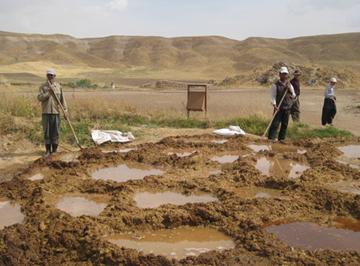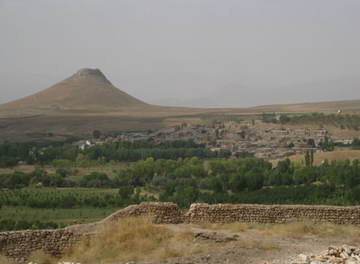It was autumn in Iran's province of West Azerbaijan and village roofs were sprouting towering, bristling stacks of hay and straw, agricultural high-rises to see precious animals through the approaching winter.
 Men, women and beasts need all they can muster to keep warm up here... when I visited this region in February a few years ago, the snow lay metres deep and villagers were frenetically sweeping snow off the roofs to prevent them from collapsing.
Men, women and beasts need all they can muster to keep warm up here... when I visited this region in February a few years ago, the snow lay metres deep and villagers were frenetically sweeping snow off the roofs to prevent them from collapsing.
Some of the rooftop adornments consist of straw gleaned from the undulating wheat fields that surround the villages. This is Iran's bread-basket and now that the harvest is in, the landscape is tawny gold as the stubble bakes in something of an Indian summer heat wave.
We are little more than 150km from Iran's border with Iraq. It is hard to imagine, in this tranquil rural backwater, that turmoil and destruction is so close by.
 In spring and before the harvest West Azerbaijan, with its adobe villages that seem as natural a part of the landscape has the farmlands themselves, would be alluring enough for travellers. But there is another reason for deviating from what passes as the main tourist trail in Iran.
In spring and before the harvest West Azerbaijan, with its adobe villages that seem as natural a part of the landscape has the farmlands themselves, would be alluring enough for travellers. But there is another reason for deviating from what passes as the main tourist trail in Iran.
Beside a road where shepherds still tend their flocks of sheep and goats on foot or by donkey lies one of Ithe country's most far flung World Heritage sites - Takht-e Soleiman.
Iran, at the best of times, receives proportionally few overseas tourists and some particularly adverse publicity this year has reduced that number even further.
Add to this the fact that western Iran is one of the least visited regions and it is no exaggeration to say we are well off the beaten track.
 Being the only overseas visitors in towns or villages in Iran is not unusual of course, but it still seems extraordinary to find one's group almost the sole tourists in a UNESCO-listed site on a perfect autumnal day.
Being the only overseas visitors in towns or villages in Iran is not unusual of course, but it still seems extraordinary to find one's group almost the sole tourists in a UNESCO-listed site on a perfect autumnal day.
Ancient rulers, possibly dating back to the great Persian kings, the Achaemenids in the 5th century BC, certainly knew a good location when they saw one.
Takht-e Soleiman, which translates as the throne of Solomon, is perched on the top of a volcanic plug, in the centre of which is a crater lake.
The ruins that stand here today date mostly back to the sixth and seventh centuries AD however, when Sassanian kings encircled the cone with a wall and 38 stone towers. Inside they built palaces and - most importantly - three fire temples.
This fortified town, on its volcanic cone, still dominates its surroundings, even in their semi-ruined state. In its glory days it must have been truly imposing as well as easy to defend.
 The rulers of old would not only have had the psychological advantage of being above their subjects, but would also have felt in touch with the elements, with the water mysteriously but continuously welling up in the crater lake and the wind whistling around the ramparts.
The rulers of old would not only have had the psychological advantage of being above their subjects, but would also have felt in touch with the elements, with the water mysteriously but continuously welling up in the crater lake and the wind whistling around the ramparts.
Fire temples are one of the most essential elements of the Zoroastrian religion, which was the dominant belief system in ancient Persia before the Arab invasion in the 7th Century AD.
Zoroastrianism is considered one of the first monotheistic religions and veneration of the four elements of earth, water, fire and air are vital elements of their beliefs. There are still thousands of Zoroastrians living in Iran today.
They are often wrongly called fire worshippers. Even today a fire burns continuously in their remaining fire temples, but it is not worshipped, rather used as a symbol - a visual dynamic reminder of their belief in the god Ahura Mazda and the goddess Anahita.
At Takht-e Soleiman there are three fire temples (which once housed sacred flames) and it was these that drew worshippers for many centuries.
 Just as they would thousands of years ago, visitors must walk up the slope of the volcanic cone to the arched stone gateway. What makes this entry rather different to many other castle entrances is the fast flowing stream that flanks the path. Smelling faintly of sulphur, its edges encrusted with mineral deposits, this is the outflow from the crater lake within the fortification's walls.
Just as they would thousands of years ago, visitors must walk up the slope of the volcanic cone to the arched stone gateway. What makes this entry rather different to many other castle entrances is the fast flowing stream that flanks the path. Smelling faintly of sulphur, its edges encrusted with mineral deposits, this is the outflow from the crater lake within the fortification's walls.
Even today, with the palace and temples in ruins around it, the lake exudes a powerful sense of presence. It is easy to see why it appealed as a place from which to perform religious ceremonies.
From its banks, and beyond the encircling walls, hills stretch away in all directions, with the most eye-catching of all being another dramatic volcanic cone known as Solomon's Prison.
Despite the references to Solomon, there's absolutely nothing in the archaeological finds here or the history of the site to indicate it had anything at all to do with King Solomon.
Throughout Iran there are sites named after Biblical references. It's believed this was the locals' way of protecting Zoroastrian sites, especially from destruction by the invading Muslim Arabs.
 The latter were intent on wiping out any rival religions and the locals, though willing to embrace Islam, were equally determined to protect what they still held as sacred.
The latter were intent on wiping out any rival religions and the locals, though willing to embrace Islam, were equally determined to protect what they still held as sacred.
By declaring that fire temples or palaces had links with Biblical and Koranic figures that were held sacred in Islam as they were in Judaism or Christianity, they saved them from destruction.
It seemed to work, although subsequently did lead to some historical confusion. The tomb of Darius, the great Achaemenid king, for example, was "disguised" as Solomon's mother's tomb and as a result is still intact today near Shiraz in southern Iran.
Set around the lake are the remains of royal palaces and the fire temples, one of which was dedicated to the Sassanian warrior classes.
To most visitors they are simply picturesque and ancient ruins but experts believe the barrel-vaulted palace reception rooms and other structures contain architectural elements that were later adopted by Islamic builders in the centuries that followed.
After the Mongols, including Tamerlane in the 15th century invaded, Takht-e Soleiman was abandoned and left to slowly crumble on its volcanic peak.
Now protected from further destruction (including preventing locals from using the stone ramparts and other buildings like a take-away quarry) it remains a testament to the long-lost glories of empire.
Its dramatic location is also proof that the real estate mantra of location, location, location has been in operation for several millennia.
Author: Jill Worrall | Source: NZ Herald [December 22, 2010]